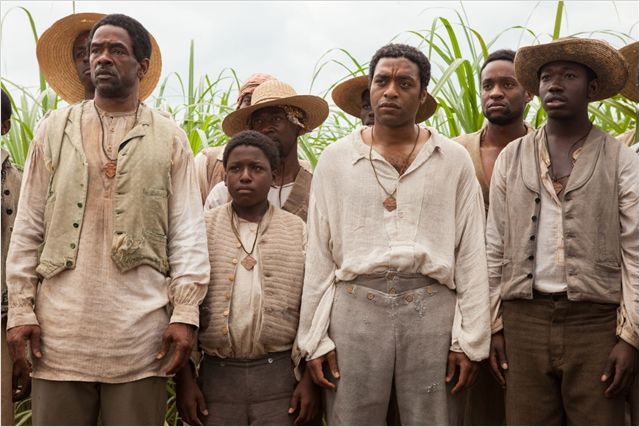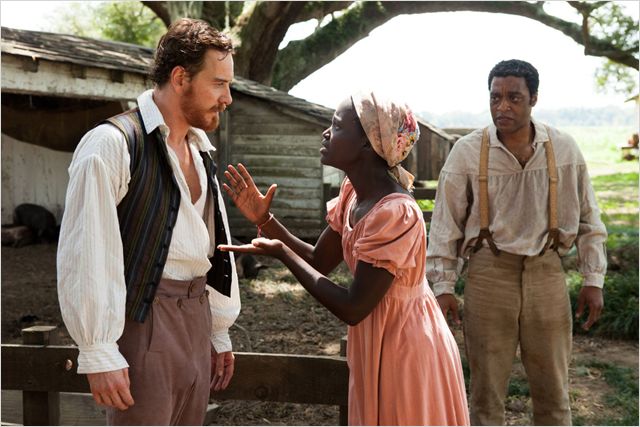The strategically choreographed national roll-out of British director Steve McQueen’s horrifying and beautiful 12 Years a Slave risks putting audiences in precisely the wrong mood for a film that shouldn’t be mistaken for just another Hollywood blockbuster set in nineteenth-century America. After a limited release to a handful of cities on October 18, with rave reviews and hype in place for a wider but still not general release on November 1—and much talk of Academy Awards nominations and an international campaign led by co-producer Brad Pitt, who also has a supporting role in the film—we might be forgiven for expecting a bien-pensant history lesson in what slavery was “really like,” and a corrective to Django Unchained (as both historians and critics have put it), amid an atmosphere of churchlike, we-dare-you-to-criticize-it reverence.
This is a disservice to McQueen, who has done something a lot more interesting than make a prequel to Spielberg’s Lincoln. It’s true that many lessons of various kinds are threaded through the film, which is based on Solomon Northup’s dignified, moving, and spirited account, first published in 1853, of his true-life kidnapping in Washington by two mountebanks who had ostensibly hired him as a fiddler, then drugged him and sold him, a free citizen of Saratoga, New York, into slavery in Louisiana. In one of the opening scenes, slaves arrayed as though for a group photograph of collective misery are instructed in how to cut sugarcane; then, in a flashback, Northup (played intensely, if perhaps with a bit too much stoic nobility, by Chiwetel Ejiofor) is cautioned by a fellow slave in how to keep silent about his true identity and his ability to read and write in order to survive (“I don’t want to survive,” Northup says, “I want to live!”). And, as the film descends into depravity and darkness, the sadistic, Bible-quoting cotton planter Epps (Michael Fassbender) tells his “property,” again in frontal array, how to avoid having “stripes” inflicted on their backs.
But the best sequences in 12 Years a Slave are not history lessons. They are, instead, visually ambiguous and open-ended, presumably owing something to McQueen’s art-school background in Britain and his experience in making experimental art films (for which he won the prestigious Turner Prize in 1999)—work that showed a professed admiration for, of all things, Warhol’s painfully drawn-out short films. After a festive night of partying in a Washington restaurant, a man (whom we soon recognize as Solomon) wakes up hooded and manacled in a redbrick cell. As Solomon explores his newly limited range of motion, in a scene that feels like a dance by Merce Cunningham or a reenactment of one of Goya’s Disasters of War (another of McQueen’s acknowledged influences), the camera takes its own good time trying to make sense of the situation.
Late in the film, as Solomon’s hopes for freedom are repeatedly dashed by bad luck and betrayal, McQueen risks a sustained, silent stare at Solomon’s face, allowing us to guess what his emotions are. Time passing—how, without intrusive verbal titles, or gray hair and wrinkles, do you convey the duration of twelve excruciatingly long years?—is expressed in slow, soundless pans of Louisiana swamps, gaunt trees wreathed in moss at dawn and sunset. At such moments, one feels that McQueen would almost have been happy making 12 Years a Slave as a silent film, with a meditative slowness almost non-existent in current Hollywood productions.
If the film is visually stunning, the script (by John Ridley) is less so. Ejiofor, Fassbender, Paul Dano (as the weak and vindictive overseer Tibeats), Lupita Nyong’o (as Epps’s slave concubine, Patsey), and Sarah Paulson as the jealous Mistress Epps are all superb, completely inside their roles, natural and unsettling. Some of the other characters seem to have strayed from another movie, some period costume drama replete with stagey “acting,” intruding needlessly on McQueen’s more severe aesthetic instincts.
I’m not sure what Paul Giamatti, as the cartoonishly hyperactive slave-trader Freeman, could have done with his lame lines. Asked by the relatively benevolent slaveholder William Ford (Benedict Cumberbatch) if, in separating a wretched slave mother from her daughter, he’s completely lacking in sentiment, Giamatti says, “My sentimentality extends the length of a coin.” At the opposite end of the moral spectrum, Brad Pitt, as the hunky, smarmy Canadian abolitionist who finally engineers Solomon’s freedom, has wooden lines (he says that to free Solomon “wouldn’t be just a pleasure, but a duty,” or some such thing) and a wooden demeanor, a waste of a talented actor.
The clichéd figure of the noble Northerner also distracts from the historical truth of slavery as a national crime, not just a sectional one. “As far back as I have been able to ascertain,” Northup writes in Twelve Years a Slave, “my ancestors on the paternal side were slaves in Rhode Island.” Harriet Beecher Stowe, to whom Northup dedicated his book, deliberately made the slave-owning plantation owner Simon Legree, an obvious prototype for Epps, a transplanted New Englander. I wasn’t wild about a melodramatic parting shot of the city of Washington, with the camera crawling up the wall of Simon’s brick cell and, reaching the top, lingering on the unfinished Capitol dome in the distance, like the unfulfilled national promise of equality and liberty—but it sends the right message that this country was founded on slavery.
Advertisement
The film is unflinching in its portrayal of brutality. Noosed, strung up, and choking with just his toes touching the dirt in punishment for attacking the overseer Tibeats, Northup seems to hang forever, as daily life goes on about him. Women caught up in the obscene sexual and property relations of slavery are as sadistic as the men. And yet, the film itself does not avoid sentimentality. The stilted reunion with Solomon’s family at the end (a grandson! and named Solomon!) is a tearjerker unworthy of the rest of this generally austere film. And there is too much Aaron-Copland-like schmaltz in Hans Zimmer’s soundtrack (one can’t help but think that this was imposed on McQueen, who has such a good instinct for the uses of silence); it recurs annoyingly in the flashbacks of life in Saratoga, and is again reminiscent of Lincoln, with its uplifting John Williams score.
This is particularly disappointing since Solomon Northup’s book is about an artist whose self-confessed “ruling passion” was playing the violin. “Had it not been for my beloved violin,” Northup, without specifying how he learned to play, recalls, “I scarcely can conceive how I could have endured the long years of bondage.” If he had a free moment on Sunday, he would steal away to a quiet place on the bayou and listen to his violin “lifting up its voice.” He tells us how “at midnight, when sleep had fled affrighted from the cabin, and my soul was disturbed and troubled with the contemplation of my fate, it would sing me a song of peace.” The film, for some reason, never lets us see or hear this intimate love of music, confining Solomon to fiddling joylessly for dances at the behest or command of white people. Since we never hear him playing for pleasure or solace, the scene where he destroys his violin, apparently in desperation (it’s not in Northup’s book), lacks emotional punch.
McQueen does make powerful use of the “slave songs” Northup vividly describes in his book. At a slave burial, the survivors take up the song “Roll, Jordan, Roll,” which recurs in the closing credits. Northup listens blankly for a chorus or two, then joins in, in an ever more resonant baritone, signifying either his defiant humanity (“I want to live!”) or his resignation and solidarity with the other slaves. There is at least one other brilliant musical stroke when, following Solomon’s kidnapping, the momentarily percussive soundtrack is revealed to be the whirring paddlewheel of a steamboat descending the Mississippi with its cargo of slaves into the heart of darkness, more menacing than the river of Apocalypse Now.
The true and lacerating moral and emotional ending of the movie comes just before the family reunion in Saratoga, when Solomon climbs into a carriage bound for freedom, with Epps yapping at his heels, and leaving Patsey, for whom Northup has developed a deep sympathy, behind. We have learned that Patsey is an artist, too, making exquisitely crafted cornhusk dolls. But her life, compressed into picking cotton by day and being raped and beaten by Epps at night, has made her wish for nothing but death, which she has even requested at Solomon’s hands. In a horrifying scene, he almost ends up delivering it, at Epps’s command, with a bullwhip on Patsey’s bare back, after Epps, with his vindictive wife egging him on, has threatened that all the slaves will pay if Solomon balks.
According to Northup’s memoir, slaves in the Deep South were limited to three “free” days a year, for Christmas. “Such is ‘southern life as it is,’” he wrote icily, “three days a year, as I found it—the other three hundred and sixty-two being days of weariness, and fear, and suffering, and unremitting labor.” 12 Years a Slave is about what it is feels like for a free man, someone like you or me, to find himself suddenly turned into a slave. In this regard, it resembles stories of struggles against imprisonment like Hitchcock’s The Wrong Man, or McQueen’s 2008 film Hunger, about Bobby Sands’s hunger strike. McQueen, who lives in Amsterdam, has compared Northup’s memoir to The Diary of Anne Frank.
Advertisement
But what it might be like for a free man to be, temporarily, enslaved is a very different thing from what it’s like for a slave to be a slave, and not for twelve years but for generations of weariness and fear and suffering and unremitting labor.
For that, we would need Patsey’s story.





